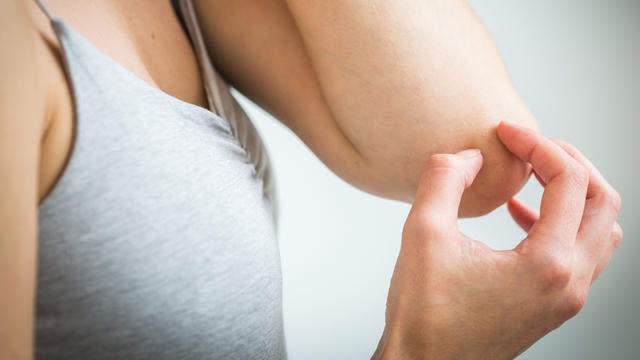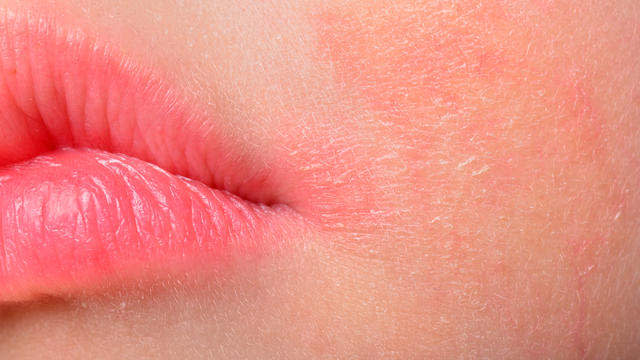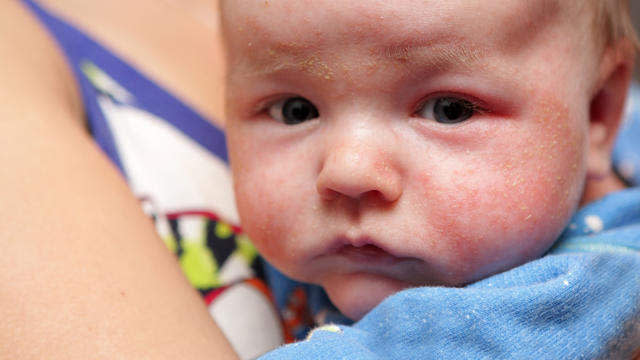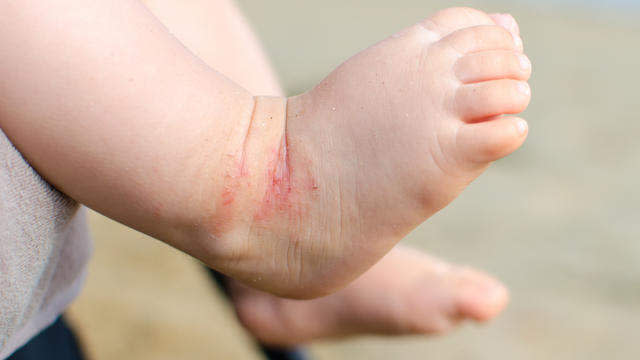What Is Eczema?

Jump to: Types | Symptoms | Causes | Pictures | Diagnosis | Treatment | Medications | When to see a doctor | Eczema in babies | Is it contagious? |
Because eczema is often used as an umbrella term for a group of chronic, itchy skin rashes, a simple definition of the skin condition is hard to come by. Many people with eczema develop dry, itchy, red patches of skin. In some forms of eczema, blisters develop. Scratching can inflame the rash and cause “weeping” of clear fluid. Over time, the affected patches of skin can thicken. Eczema can look different depending on the type of rash and where it appears on the body. Symptoms typically flare up for a period of time and then calm down before surfacing again. More than 30 million Americans have some form of eczema. While the exact cause is unclear, a combination of factors, such as genes, environment, and immune system are thought to play a role.
Types of eczema
Atopic dermatitis
Atopic dermatitis is the most common form of the skin condition, and it’s usually what people are referring to when they talk about eczema. About one in five children develop atopic dermatitis, often in infancy and usually by age 5. (Only a small percentage of adults develop this type of eczema.)
Dry, scaly, red, and itchy patches can appear on the face, scalp, hands, or feet; inside the elbows; or behind the knees. In more severe cases, these patches crack and crust over, and they can become infected. Atopic dermatitis comes and goes, with periods when symptoms are worse and other times when the rash goes into remission and disappears. It tends to occur in families with a history of this eczema, hay fever, or asthma. It can be a lifelong condition, although some children outgrow it or see symptom improvement as they age.
Dyshidrotic eczema
With this type of eczema, itchy, fluid-filled blisters develop under the skin on the hands or the feet, especially palms, soles, or sides of the fingers. Patches of flaky, red skin can develop. Over time, the affected skin can become thick and cracked.
Dyshidrotic eczema (also called pompholyx) may be aggravated by stress or frequent or long periods of contact with water. Working with certain metals—such as chromium, cobalt, or nickel—can trigger symptoms. It is more common in women, and there is a higher risk if you have had atopic dermatitis (eczema) or allergic rhinitis (hay fever). It tends to occur in spring and summer and in warmer climates.
Nummular eczema
Round or oval areas of itchy, inflamed sores are the hallmark of this type of eczema, which is also called nummular dermatitis or discoid eczema.
Clusters of tiny pimples form plaques, or patches, that become scaly. One or more areas of the skin, usually on the arms and legs, can be affected. It is more common in older males, but young women can get it, too. Nummular eczema tends to occur in people with dry skin, especially in winter. Like other types of eczema, symptoms can come and go. New patches may form where there was injury to the skin (such as an insect bite). Keeping skin moisturized can help prevent future flare-ups.
RELATED: What ‘The Night Of’ Gets Right (and Wrong) About Eczema
Signs and symptoms of eczema
How do you know a rash is eczema and not psoriasis or another skin condition? Eczema is usually accompanied by uncontrollable itching that worsens when you scratch it and can interfere with sleep. People sometimes scratch until they bleed, yet itching persists, and the wound becomes vulnerable to infection.
The signs and symptoms of eczema can vary from one person to the next.
Atopic dermatitis, the most common type of eczema, usually strikes in childhood. Babies tend to develop a red rash on their cheeks and scalp that turns dry and scaly. The rash can bubble up, ooze, and crust over. In young children, other body sites may be affected, such as the inside folds of the elbows or knees, or the hands, wrists, or feet. Over time, these patches can lighten or darken, and they may become thick and bumpy and constantly itchy.
Dyshidrotic eczema typically strikes the hands and feet. People with this type of eczema develop small, fluid-filled blisters that itch and burn. The blisters weep, crust over, and crack, exposing the skin to painful infection.
Nummular eczema produces pimples or blisters that leak fluid and form crusty, coin-shaped patches on the legs, arms, hands, feet, or torso. It occurs more often in the winter months.
Symptoms of eczema
Severe itching
Red rash
Dry, rough, scaly patches
Blistering
Oozing
Painful skin cracking
What causes eczema?
While the exact cause of eczema is unknown, scientists believe it’s a product of your genes and the environment. Eczema risk is greater in children whose parents had eczema or a condition like asthma or hay fever.
Usually the skin serves as a shield against toxins, bacteria, and allergens. With eczema, that protective barrier dries out and is easily breached by irritants in the environment. Exposure to household products (such as soap, detergent, or fragrances) or to allergens (dust, pollen, or pet dander) may trigger eczema symptoms.
Other factors that may cause asthma symptoms to flare include stress and anxiety; cold or dry weather; dust, sand, or pollution; and wearing wool or synthetic fibers.
Eczema pictures
Eczema typically produces a red, itchy, scaly rash, but exact symptoms can differ from person to person. What eczema looks like may depend on the type of eczema. Eczema rash can affect different body parts, from the scalp to the toes. Some people may develop a patch or two of inflammation, while others have multiple lesions. Eczema symptoms can range from mild to severe.
Atopic dermatitis, the most common type of eczema, usually begins in infancy or childhood. The first sign of eczema in babies is often red cheeks. In children, eczema usually appears in the inner folds on the elbows and knees. Dyshidrotic eczema is more common in young adults. It produces fluid-filled blisters on the hands and feet. Older men are more likely to develop nummular eczema, which produces distinctive circular or oval patches of blistered, scaly rash.

Eczema on face

A red, itchy rash across the cheeks and chin is often the first sign of atopic dermatitis (eczema) in infants. Eventually, the rash begins to ooze and crust over, and drooling can worsen symptoms. Eczema rash may improve or disappear as children get older, although some people continue to experience flare-ups as adults. Treatment for mild eczema on the face may include topical ointments or creams as well as moisturizers.
Eczema on hands
Dry, chapped, and itchy skin on the hands that doesn’t improve with moisturizer may be a sign of hand eczema. Symptoms can include red, itchy, inflamed skin with blistering that can lead to oozing, crusting, and cracking. People who have their hands in water all day or work closely with irritants such as detergents or solvents are more likely to develop this type of eczema. If you had atopic dermatitis as a child, you may also have a higher risk of developing hand eczema. Applying a cream after washing hands or wearing gloves may help protect hands from future flare-ups.
Scalp eczema

Eczema in babies can spread to other body parts, including the scalp. It is red, itchy and crusty. This is different from “cradle cap” (also known as seborrheic dermatitis), which produces redness and white or yellow flakes on the scalp. Treatment for scalp eczema may include a topical ointment applied to the rash.
How is eczema diagnosed?
There’s no single test for diagnosing eczema. Your doctor or your child’s pediatrician will conduct a physical exam. Some patients may be referred to a dermatologist or allergist. Doctors look for typical signs and symptoms of eczema, such as itching and rash.
The difficulty is often ruling out other conditions that cause irritating skin symptoms. Atopic dermatitis, for example, may be confused with seborrheic dermatitis (a common condition that mainly affects the scalp), while nummular eczema may resemble ringworm (a contagious fungal infection). Sometimes a skin patch test or allergy test may be required to confirm an eczema diagnosis by ruling out other conditions.
Expect your doctor to ask about your family history of allergic disease, since eczema can run in families. Kids with eczema can also go on to develop food allergy, hay fever (also known as allergic rhinitis), and asthma—usually in that order (this is sometimes called the “atopic march”).
Tell your doctor when symptoms first appeared, how often you or your child experiences symptoms, other body parts that are affected, whether the problem comes and goes, and when it seems to flare up. Your doctor may ask about any allergies you or your child have and potential triggers of symptoms.
Eczema treatment
Unfortunately, there’s no single magic bullet to get rid of eczema. But there are a number of treatments and strategies for relieving symptoms, reducing inflammation, and preventing flare-ups. These include ointments and creams that are applied to the skin, oral antibiotics or antihistamines, and an injectable medication.
Restoring moisture is crucial for preventing symptom flare-ups. Soaks and wet wraps can soothe pain and itching. Prescription and over-the-counter moisturizers can help repair dry skin and keep it hydrated.
Steroid ointments and creams have long been the go-to remedy to clear up eczema rash. These topical treatments (also called corticosteroids) can help reduce inflammation and alleviate symptoms during a flare-up. But they are not recommended for long-term use due to serious potential side effects. Topical steroids come in different strengths, so if one doesn’t do the job, your doctor may switch to a more potent version.
Newer non-steroidal medicines called calcineurin inhibitors are another option. These drugs include Elidel (pimecrolimus) cream for mild-to-moderate eczema and Protopic (tacrolimus) ointment is approved for moderate-to-severe symptoms.
Eucrisa (crisaborole) ointment 2% is another option for eczema patients 2 years old and older. Approved by the U.S. Food and Drug Administration in December 2016, Eucrisa inhibits an enzyme that promotes inflammation.
The newest weapon against eczema, approved in March 2017, is Dupixent (dupilumab) for adults with moderate-to-severe atopic dermatitis. It is administered as an injection under the skin and is intended for people whose eczema is not controlled by topical therapies or for whom topical treatment isn’t recommended. The active ingredient in Dupixent is an antibody that blocks a protein that causes inflammation.
Light therapy (also called phototherapy) using a special device that emits ultraviolet light is an option for clearing difficult-to-treat eczema and rashes that are dispersed across the body.
Topical products containing coal tar or antihistamines may be prescribed for itch relief.
An antibiotic may be given to treat bacterial skin infections. Diluted bleach baths are sometimes used to treat baby eczema that results in frequent infections. (Be sure to consult your doctor first for specific instructions.)
Medications
Topical steroids such as hydrocortisone cream to relieve inflammation
Calcineurin inhibitors such as Elidel (pimecrolimus) cream and Protopic (tacrolimus) ointment
Eucrisa (crisaborole 2% ointment)
Dupixent (dupilumab), an injectable drug
Antihistamines to control itch
Prescription or over-the-counter moisturizers
Antibiotics to treat infections that may arise
When to see a doctor
If you suspect eczema, see a doctor who can diagnose the condition and recommend treatments to heal the rash and prevent future flare-ups.
Eczema requires a lot of self-care. You’ll need to recognize and avoid triggers, including allergens and other skin irritants. Keeping skin moisturized and avoiding temperature extremes—heat that makes you sweat or low humidity that zaps the skin of moisture—may be important strategies for managing eczema.
There might be times when you or your child must seek additional advice and follow-up care. Consult your doctor about making dietary changes if your or your child’s symptoms, medical history, and diagnostic testing suggest that food allergies may be an eczema trigger. You should also see a doctor right away if signs of infection are present. Patches of eczema with yellow crusting or pus-filled blisters, or areas around the patches that are red, hot, swollen, and painful may signal that skin is infected.
Report any change in the severity of eczema symptoms. And if a prescribed treatment doesn’t seem to be working, contact your doctor about adjusting your medication.
Eczema in babies

Atopic dermatitis, the most common type of eczema, often develops before age 1, and 90% of people who have it get it by age 5, reports the American Academy of Dermatology.
Baby eczema can look different from eczema in children or adults. In the first six months of life, babies may develop red, oozing rashes on the scalp and face, especially the cheeks, chin, and forehead. Later in infancy, eczema rash can pop up on elbows and knees.
To manage baby eczema, it is important to know what may trigger a flare-up of symptoms. Common triggers include pollen, pet dander, dust, smoke, soap, shampoo, certain foods, infection, and wool or synthetic fabric.
Having a good bathing and moisturizing routine can keep your baby’s skin hydrated. Here’s what the American Academy of Dermatology recommends:
Gather bath supplies and place them near the tub
Bathe baby in warm water for 5 to 10 minutes (an occasional 20-minute bath is okay, but skip the bubble bath, which can cause a flare-up)
Only wash baby’s dirty and smelly parts, and only use fragrance- and dye-free cleansers
Gently clean; do not scrub the skin
Immediately after bathing, pat your baby dry and apply ointment or cream to lock in moisture
Is eczema contagious?
Eczema is not contagious. You cannot get it from someone or spread it to other people. Although scientists don’t know exactly what causes eczema, the current thinking is that it’s your genes and the environment that set the stage for the condition.
However, having eczema may expose the skin to bacterial, viral, or fungal infections, which can spread to other parts of the body or to others through skin-to-skin contact.
Dry, cracking skin creates an entryway for foreign invaders. Scratching itchy eczema patches can also introduce infection. In either case, when infection sets in, eczema can worsen and become more difficult to treat.
Fever, oozing, and pus-filled blisters may be signs of infection.
